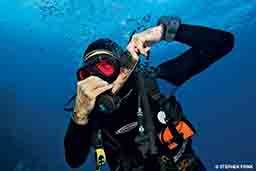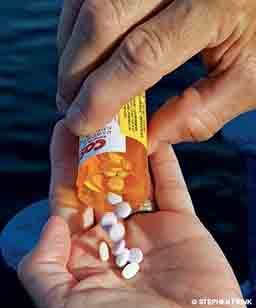Q: If I am not wearing a hood I have no problems equalizing my ears. When I wear a hood I always have great difficulty. Why the difference?

A: When we pressurize the middle-ear space using a Valsalva maneuver or other equalization technique, the tympanic membrane (ear drum) bulges outward slightly. If the ear canal is uncovered and can transmit that pressure, the water in the ear canal moves easily in response. A hood that fits snugly against the outer ear can greatly restrict the movement of this water, hampering the diver’s ability to equalize.
One of the easiest remedies to this is to insert a finger under the hood near the ear, which will allow the water to move more easily. Another solution some divers choose to implement is to cut a hole from the inside of the hood, near the ear canal, through the inner lining and the neoprene but leaving the outer fabric or covering intact. The hole allows the water to move with little restriction.
— Marty McCafferty, EMT-P, DMT
Q: In a few weeks I’ll be doing my first dive trip on a liveaboard. Several friends of mine who are veterans of liveaboards suggested I use a sleep medication (zolpidem or zopiclone), since travel and the environment can disrupt normal sleep patterns. I would like to use them so as not to be sleep deprived, but how safe are they in a context of frequent diving?
A: Both medications have been shown to be less problematic for most individuals than other hypnotics or sedatives. However, they are not without risk. There is evidence both from clinical trials and field reports that misuse of these medications can impair one’s ability to safely drive a car. The physical and cognitive skills required for diving are very similar to the demands of driving, so it is reasonable to draw a parallel between the two activities. To reduce the risk of impairment, it is essential to take either medication as directed. The medication should be taken just prior to retiring for a night of eight hours of uninterrupted sleep.

Time-zone changes may affect circadian rhythms, and employing measures to adjust will help sleep disturbances. Many divers find the active environment extremely conducive to sleep and are pleasantly surprised at their ability to sleep well at the end of a busy dive day.
It is important to discuss the use of these medications with your doctor to determine if they are appropriate for you, especially if you are taking other medications or have medical conditions such as sleep apnea. It is equally important to try the medication well in advance of your dive trip to assess its effects and any potential impairment in a safe and familiar environment.
Another important factor to consider is that one of the medications you mentioned requires less time than the other for the body to eliminate. This does not preclude the use of either, but depending on your sensitivity the shorter-acting medication may be a prudent choice. In addition, there is some clinical evidence that people 65 and older may take longer to eliminate the medication from the body. If you awake in the morning after using the medication fully alert and unimpaired, diving is possible. This will require a brutally honest evaluation by you and your dive buddy; most medications have rare side effects, and it’s important to determine whether yours is the rare case.
— Marty McCafferty, EMT-P, DMT
Q: My friends and I take turns every weekend “jumping wrecks.” The person whose job it is that weekend to attach us to the wrecks does two dives (one to secure the boat and one to release it) on two wrecks, both around 100 feet deep. Each of the four dives takes a little more than five minutes, and all surface intervals are about one hour. The person who ties us to the wreck always sits out the other dives, fishing and catching a tan while the others dive. We use an ascent rate of 60 feet per minute. Should we be doing safety stops for the short dives to secure the boat?
A: Quick dives to tie in to a wreck will not deliver much inert gas to slow or even intermediate tissues. Fast tissues, however, can be significantly loaded, particularly with the depth and exercise intensity that can be substantial on these dives. Brief stops can add a safety factor in two ways: first, by slowing the ascent speed in anticipation of the stop, and second, with the additional stop time for equilibration.
DAN conducted an ascent-rate study a number of years ago that was ended early due to an overwhelming increase in risk associated with fast ascent rates. You may be surprised to learn that 60 feet per minute was the “fast” rate. Having said that, though, it is important to realize that a uniformly slow rate may be counterproductive since this can prolong inert-gas loading in the deeper phase of the dive.
One strategy that considers relative pressure change would be to maintain a standard ascent through something less than the first half of the pressure reduction (ascent), and then to progressively slow from there to the point of performing a shallow stop to benefit the fastest tissues (lungs, blood, then brain). For example, the depth with one-half the pressure of 100 feet is 33 feet. It could be a reasonable strategy to start slowing the ascent around 40 feet and ascending progressively slower until you halt the ascent at around 15 feet. There is no magic number for the best stop duration. One minute might be OK for a short, low-effort dive; two to three minutes (or more) might be reasonable if there was greater work involved. It is important to bear in mind that safety stops by design provide extra cushion — conservatism — in the exposure. Missing them does not guarantee a bad outcome. At the same time, not having a problem following a missed stop does not mean that the stop has no value. The safety-oriented mindset is one that has you incorporating comfortable safety factors wherever feasible to increase the odds of a successful outcome.
Understanding the importance of relative pressure change is important in managing decompression stress. Thoughtful ascent from any dive, long or short, is inexpensive insurance. The fact that you are thinking about the question weighs heavily in your favor.
— Neal W. Pollock, Ph.D
| Q: I’m an avid scuba diver and spearfisher. I’m now pregnant, and as I expected, my doctor told me I shouldn’t scuba dive. But I was surprised when he said I should not freedive either. What’s the logic behind that, or is he simply overcautious? |
A: Ethical considerations have limited both the scope and number of studies on pregnancy and diving (freediving and scuba diving). Most of the literature that’s available is purely anecdotal or consists of data collected after delivery. In the book Women and Pressure: Diving and Altitude (Caroline E. Fife, M.D., and Marguerite St. Leger Dowse, eds., Best Publishing, 2010), Maida Beth Taylor, M.D., cites a retrospective questionnaire that showed higher rates of low birth weight, birth defects, neonatal respiratory difficulties and other problems associated with scuba diving during pregnancy. These data are limited but sufficient to lead medical professionals to recommend against scuba diving while pregnant or trying to conceive.

The data on freediving and pregnancy are even more limited. Most of the research on breath-hold diving and pregnancy comes from Ama divers in Japan and Korea. These female divers are revered for their diving prowess, and the Ama tradition dates back thousands of years. Many of these divers continue to freedive throughout pregnancy, although they modify their profiles as gestation progresses. While Ama divers may continue to dive until the day of delivery, they typically stay close to shore in the later stages of pregnancy. Some Ama divers choose not to dive at all while pregnant.
Taylor states that there is a theoretical — and occasionally real — risk of decompression illness in freediving. However, this risk is usually associated with extreme freediving such as that practiced by Ama divers. Among Ama divers specifically, no adverse effects have been reported in infants. However, the closed nature of Asian traditional diving communities makes it difficult to garner detailed information, and the divers may be reluctant to visit medical facilities.
Taylor concludes that it is reasonable for pregnant women to freedive but that it should not be considered a good form of exercise for them. If freediving is a regular occupation, she judges it to be safe to continue provided that weight gain and other signs of a healthy pregnancy progress appropriately. If maternal parameters fall, something less strenuous is indicated. Ultimately, the decision is the woman’s and should be made in consultation with her doctor. DAN medics are available for consultation as well.
— Lana Sorrell, EMT, DMT